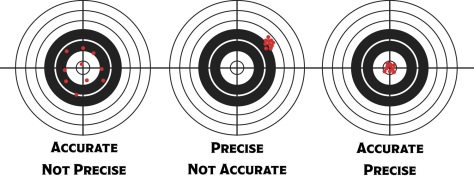The goal of any trigger pull is to put your bullet into the target at the intended spot. Once the trigger is pulled, the bullet starts its journey. Along the way, it will fall under the influence of many factors. These factors are divided into three distinct regions, each with their own ballistics.
Table of Contents
Ballistic Properties
Three Ballistic Zones
While spinning its way down the rifle’s barrel, the bullet is under the influence of internal ballistics. These are the factors that affect a bullet while still inside the rifle, such as the evenness of the bore and the burn rate of the powder. As the bullet leaves the barrel in a cloud of high pressure gas, it falls under the effects of transitional ballistics. These are the factors that affect a bullet as the wave of gas pressure meets open air. Once finally free of the shove of burning propellant, the bullet flies under the effects of external ballistics. These are the factors that affect a bullet as it arcs through the air, including air density, gravity, and wind.

The attached articles will serve to put the rest of the site in context. The rifle is the realm of internal ballistics and has a large effect on transitional ballistics. You and the rifle must work together to send the bullet on the right path, accounting for the external ballistics. All three are important, and any issues in one will have a compounding effect further on. A small change of velocity inside the rifle will eventually, far down range, lead your bullet to impact the wrong spot.
Terminal Ballistics
Secretly, a fourth study of ballistics exists: terminal ballistics. Terminal ballistics describe the actions and qualities of the bullet in the moments that it impacts a target. However, that brief and sudden moment of time is beyond the scope of this site (for now). My goal is to get your bullet to meet your target. What the bullet does when it gets there will entirely depend on what you wanted it to do, and what steps you’ve taken to get there.
In regards to terminal ballistics, I’ll make one important note. Do not shoot full-power rifle rounds at steel targets closer than 50 yards. Bullets, especially when jacketed or alloyed for increased hardness, may fragment upon hitting a steel target. Those metal fragments are hot, sharp, and travel back towards you very quickly. I can say with experience that those same bullet fragments will puncture your shirt and then skin under the right conditions. If you’re shooting a target closer than 50 yards, please let it be made of paper, cardboard, or wood. Otherwise, just use a .22 LR round or something else low-power.
As many hunters and target shooters will attest – regardless of your round, shot placement is of utmost importance. It’s less about the size of your round than how you use it.
Precision vs. Accuracy
Before we break into the basics of ballistics, it’s important to note the difference between precision and accuracy. On paper, the terms seem quite similar. However, you’ll need both attributes to stay reliably on-target.
Accuracy, in a scientific sense, refers to how close an expected measurement is to the true value. In a ballistic sense, it’s a measurement of how close your shots land to the spot you’re aiming at. Precision describes how close your measurements are to one another. In a ballistic sense, this is a measure of how close your shots land to each other.
While the image below will describe things very capably, here’s a few written scenarios:
- If your shots are grouped together closely and are in the bullseye, you’re both accurate and precise. This is good for any style of shooting.
- If your shots are spread out across a wider area and all roughly centered around the bullseye, you are accurate and not precise. This is usable for shooting steel plates or hunting large game, and is known as practical accuracy.
- If your shots are grouped together closely but are a ways away from the bullseye, you are precise but not accurate. This is useful for judging adjustments that need to be made, as well as for testing the inherent precision of your equipment.
- If your shots are spread out and not centered around the bullseye, you are neither accurate nor precise. Much work remains to be done.

Most importantly, you can only reliably measure your accuracy and precision if you shoot multiple rounds. Multiple rounds fired at the same target, while holding the same aiming point, is known as a grouping. You’re looking for how your shots group together, if at all. We’ll go into the importance of a group more in a later article, when you start firing your rifle.
For now, just remember – more shots on target means more data for your DOPE book.

Released
Updated



